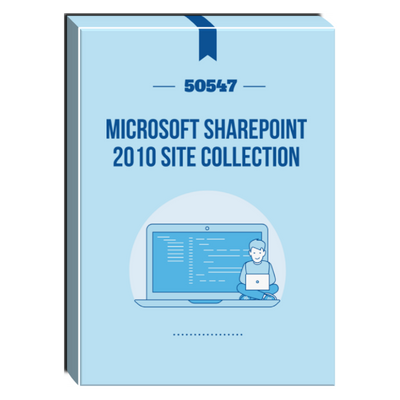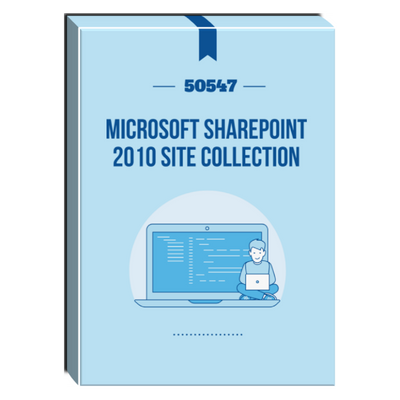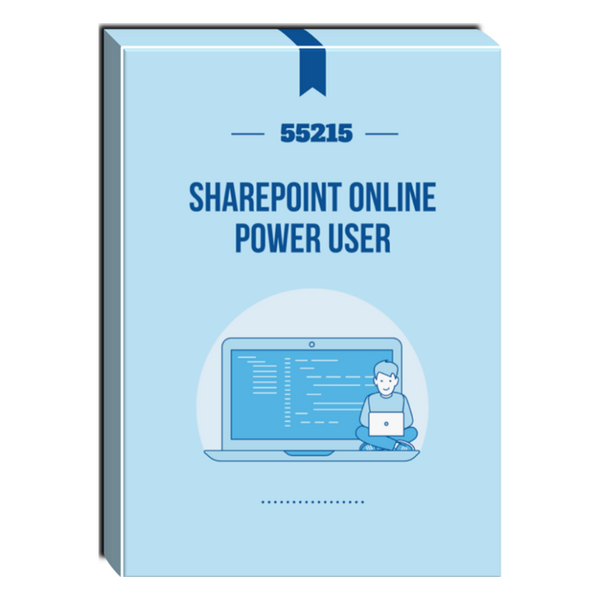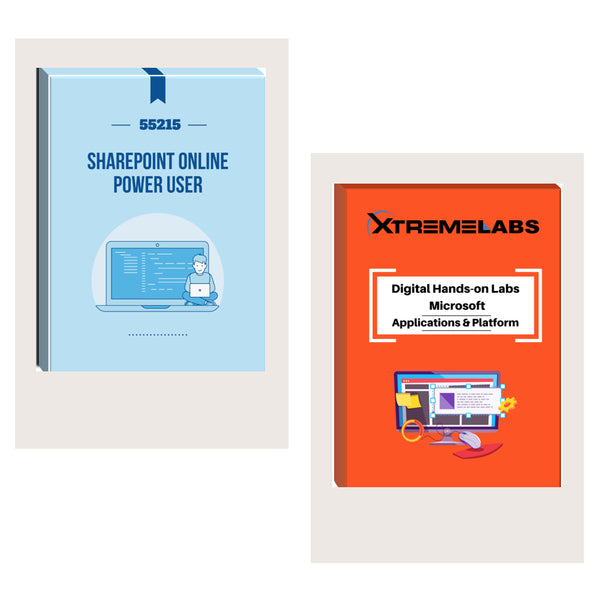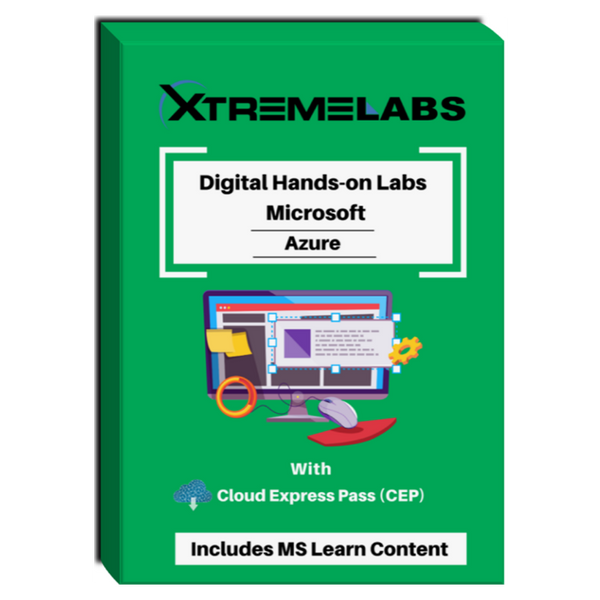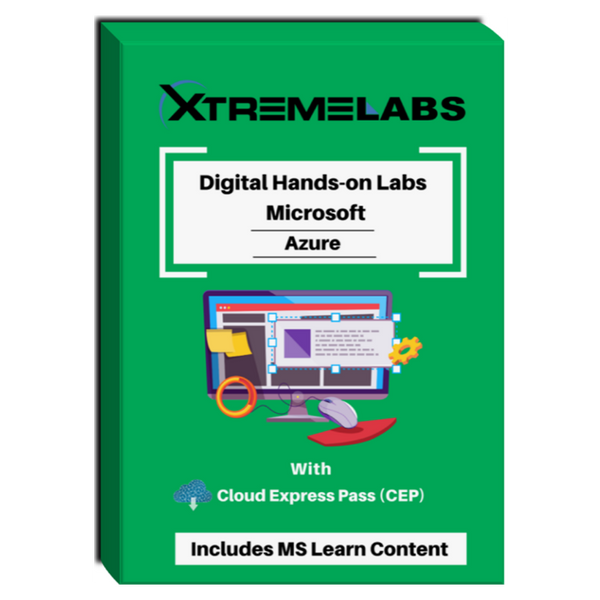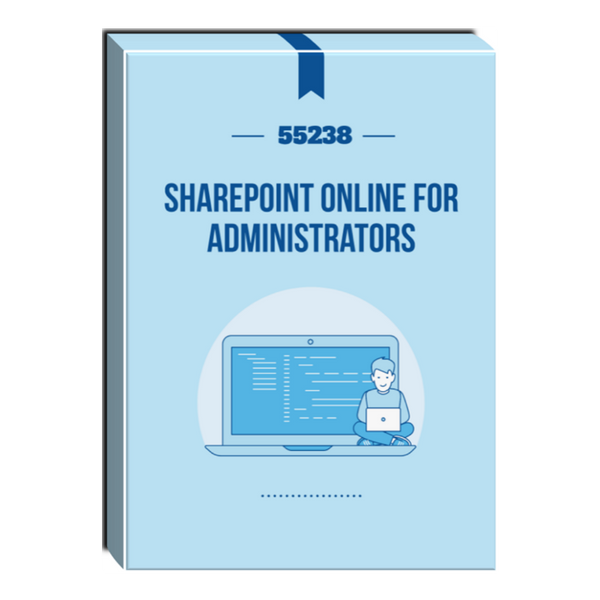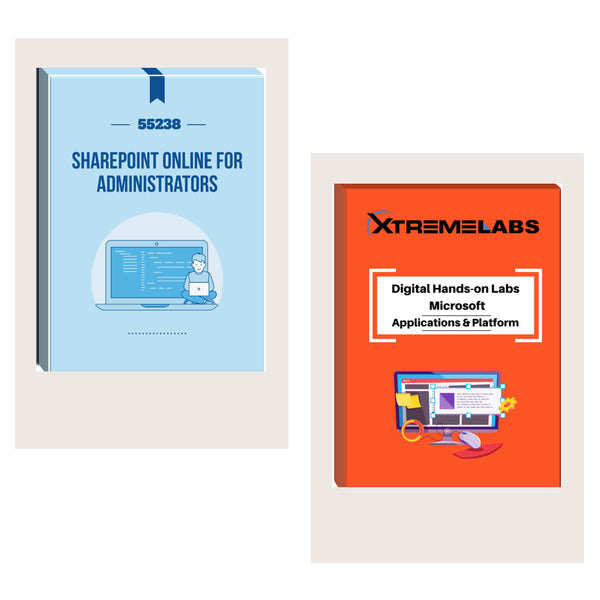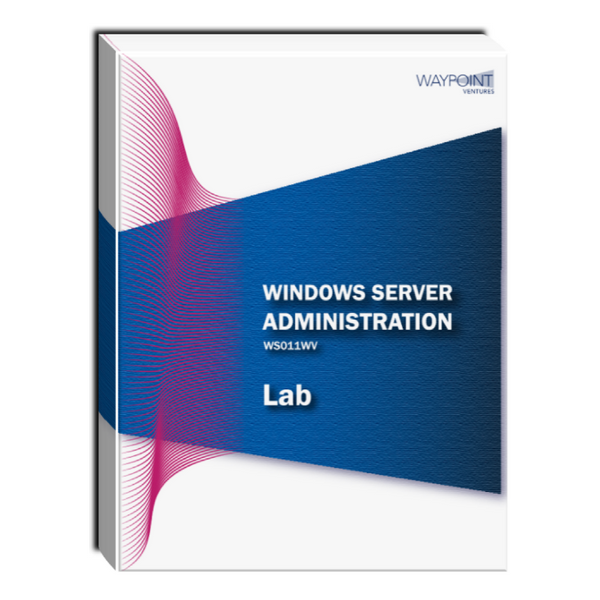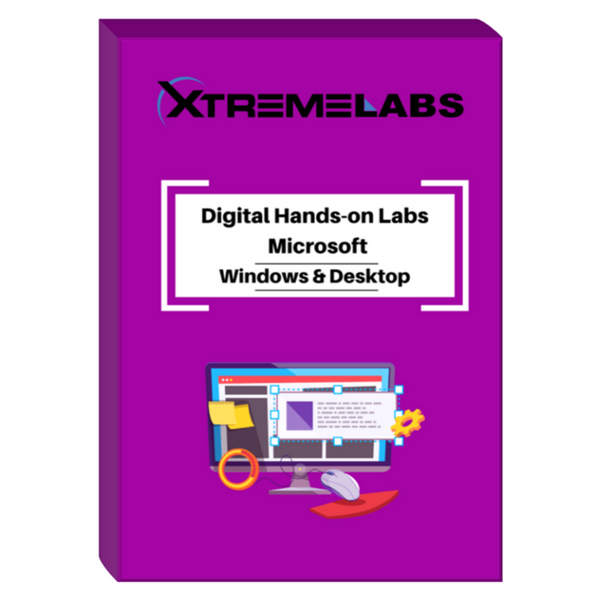Tags: Courseware , SharePoint , sharepoint 2010 site collection , SharePoint Server , sharepoint site collection , sharepoint site collection administration , site collection in sharepoint
50547: SharePoint 2010 Site Collection and Site Administration Courseware
- Brand: Torchwood Innovations, LLP
- Availability: In Stock
$215.00
This five-day instructor-led Site Collection and Site Administrator course gives students who have SharePoint 2010 Owner permissions for a site the ability to manage, administer and modify a SharePoint 2010 site based on business needs and objectives. This course also provides the IT Business Analyst the necessary information to advise...
This five-day instructor-led Site Collection and Site Administrator course gives students who have SharePoint 2010 Owner permissions for a site the ability to manage, administer and modify a SharePoint 2010 site based on business needs and objectives. This course also provides the IT Business Analyst the necessary information to advise business units on which features are a best fit for their business processes. The course will provide students necessary information on SharePoint 2010 features and capabilities including how to implement and Best Practices for implementing the feature. The course will also focus on different aspects of Governance, Office 2010 integration, workflows, web parts and much more, helping students to understand the depth and breadth of SharePoint 2010.
Audience Profile
At Course Completion
- Create and modify SharePoint 2010 objects.
- Understand SharePoint 2010 governance at the site collection and site levels.
- Understand SharePoint 2010 planning principals.
- Understand Office 2010 and SharePoint 2010 integration.
- Modify SharePoint 2010 to improve the built-in search.
Module 1: SharePoint 2010 General Overview
Lessons
- SharePoint 2010 Site Collection and Site Administrator Roles
- SharePoint 2010 Wheel
- Comparing SharePoint 2010 Versions
- Expanded Browser Capabilities
- Understand the role of the SharePoint 2010 Site Collection and Site Administrator.
- Understand the SharePoint 2010 Wheel.
- Understand the differences between SharePoint Foundations 2010 and SharePoint 2010.
- Understand the expanded browser capabilities.
Module 2: SharePoint 2010 Environment – Getting Started
Lessons
- SharePoint 2010 Environment
- Navigation
- SharePoint 2010 Ribbon
- Adding and Editing Content in SharePoint 2010
- Using Your Name Menu
- Understand SharePoint 2010 Terminology and the Environment.
- Navigate around SharePoint 2010.
- Be able to use the SharePoint 2010 Ribbon.
- Be able to add and edit basic content within SharePoint 2010.
- Use the Your Name Menu.
Module 3: Organization and Development of SharePoint 2010 Sites
Lessons
- Governance and Best Practices
- Information Architecture
- Site Structure
- User Education
- Resources
- Understand Governance and Best Practices within SharePoint 2010.
- Understand Information Architecture.
- Understand how site structure can help within SharePoint 2010.
- Understand how user education can help with SharePoint 2010.
Module 4: Site Collections, Top Level Sites and Sites
Lessons
- Overview of SharePoint 2010 Hierarchy
- SharePoint 2010 Site Inventory
- Creating Sites and Subsites
- Modifying Site Navigation
- Specialty Sites
- Sites and Navigation Best Practices
Lab : Site Collections, Top Level Sites and Sites
- Exercise 1: Create a New Top Level Site
- Exercise 2: Create New Sub-Sites called New and Current Projects and Sales
- Exercise 3: Configure Navigation between the Learning Lake Site
- Exercise 4: Create a Records Center
- Exercise 5: Create a Projects Web Database site for Sales
- Exercise 6: Create and Configure a Visio Process Repository
- Exercise 7: Create a Document Workspace
- Understand the different types of SharePoint 2010 sites available.
- Know how to create SharePoint 2010 sites.
- Know how to modify site navigation.
Module 5: Creating and Modifying Libraries and Lists
Lessons
- Overview of Libraries
- Creating a Library in SharePoint 2010
- Library Inventory
- Overview of Lists
- Creating a List in SharePoint 2010
- List Inventory
- Library and List Best Practices
Lab : Creating and Modifying Libraries and Lists
- Exercise 1: Create a Custom List
- Exercise 2: Create a New Product Survey
- Exercise 3: Create a List from Excel
- Exercise 4: Create a Document Library
- Exercise 5: Create an Asset Library
- Exercise 6: Create a Wiki Page Library
- Understand the purpose of lists and libraries.
- Understand the differences between the different lists and libraries.
- Create a list or library using multiple methods.
- Customize a list form using InfoPath 2010.
Module 6: Managing Permissions for Users and Groups
Lessons
- Overview of Permissions and Security in SharePoint 2010
- Permissions within SharePoint 2010
- Managing Permissions within SharePoint 2010
- Stop Inheriting Permissions
- Creating a New SharePoint 2010 Group
- Managing Users and Groups
- Other Permissions Management Tools
- Permissions Best Practices
Lab : Managing Permissions for Users and Groups
- Exercise 1: View Permissions of SharePoint 2010 Objects
- Exercise 2: Add Users and Groups to SharePoint 2010 Objects
- Exercise 3: Create a New Managers Group with Customized Permissions
- Exercise 4: Stop Inheriting Permissions between SharePoint 2010 Objects
- Understand how permissions work within SharePoint 2010.
- Manage permissions within the site collection and site.
- Understand the tools for permissions within SharePoint 2010.
Module 7: Site/Content Management and Collaboration
Lessons
- Overview of Site and Content Management
- Content Management
- Records Management with the Records Center
- Setting up Alerts and Real Simple Syndication
- Targeting Audiences with Content
- Site and Content Management Best Practices
Lab : Site and Content Management
- Exercise 1: Modify the Current Welcome Page
- Exercise 2: Enable Content Management
- Exercise 3: Enable Content Rating
- Exercise 4: Working with Records Center
- Exercise 5: Enabling and Configuring Audience Targeting
- Understand the concept of Site and Content Management.
- Implement aspects of Site and Content Management.
- Understand and implement Records Management through Records Center.
- Setup Alerts and Real Simple Syndication feeds.
- Implement Targeting Information for Users.
Module 8: Office 2010 Integration with SharePoint 2010
Lessons
- Overview of Office 2010 and Office Web App
- Collaborating Using Outlook 2010
- Connecting and Collaborating with Office 2010 Backstage
- Connecting, Managing and Editing Documents
- Collaborating with PowerPoint 2010
- Take Information Offline with SharePoint Workspace 2010
- Integration of Visio 2010
- Integration of Access 2010
- Using InfoPath 2010 with SharePoint 2010
- Office 2010 Integration Best Practices
Lab : Office 2010 Integration with SharePoint 2010
- Exercise 1: Connect Outlook 2010 with SharePoint 2010
- Exercise 2: Collaborate with PowerPoint 2010
- Exercise 3: Connect Visio 2010 to Visio Process Repository
- Exercise 4: Working with Information Offline with Workspace 2010
- Understand the integration features between Office 2010 and SharePoint 2010.
- Understand how Office Web Apps works between the two products.
- Understand the collaboration features available with Outlook 2010.
- Understand how Excel and Word interact with SharePoint 2010.
- Understand how PowerPoint can expand collaboration and presentations.
- Understand how SharePoint 2010 can be taken offline with Workspace 2010.
- Understand the integration of Visio and Access with SharePoint 2010.
- Have a basic understanding of how InfoPath 2010 works with SharePoint 2010.
Module 9: Creating Consistency Across Sites
Lessons
- Site Columns
- Site Content Types
- Implementing Document Sets
- Show/Hide the Server Ribbon
- SharePoint Site Themes
- Overview of SharePoint Templates
- Managing Through Site Templates
- Managing Through List and Library Templates
- Page Layout and Site Template Settings
- Consistency Best Practices
Lab : Creating Consistency Across Sites
- Exercise 1: Modify the SharePoint 2010 Site Theme
- Exercise 2: Create a Site Content Type
- Exercise 3: Create Document Set for Learning Lake
- Exercise 4: Create a Site Template
- Exercise 5: Create a List and Libraries Template
- Exercise 6: Designate a Specific Page Layout and Site Templates
- Understand and use Site Content Types and Columns.
- Understand and Implement Document Sets.
- Implement and Customize SharePoint Site Themes.
Module 10: Finding Information Using Search and Views
Lessons
- Overview of Views
- Adding Columns to Lists and Libraries
- Creating Views in Lists and Libraries
- Configuring Per-Location View
- Overview of Metadata and Taxonomy for SharePoint 2010
- Implementing Managed Metadata
- Overview of Search
- Implementing Managed Keywords and Best Bets
- Using SharePoint Search
- Configuring Search Scope
- Configuring Search Visibility
- View and Search Best Practices
Lab : Finding Information Using Search and Views
- Exercise 1: Use Sorting and Grouping to Modify a View
- Exercise 2: Create a New View for Project Documents
- Exercise 3: Create Calendar and Gantt Chart Views
- Exercise 4: Create and Implement Managed Keywords and Best Bets
- Exercise 5: Optimize Project Documents for Search
- Exercise 6: Test Search to Find Information
- Understand and configure multiple types of Views.
- Understand and configure Per-location Views.
- Understand and implement Metadata within SharePoint 2010.
- See how Search and Faceted Search work.
- Configure Search Scopes and Visibility within SharePoint 2010.
Module 11: Displaying Data with Web Parts in SharePoint 2010
Lessons
- Overview of Web Parts
- Web Part Inventory
- Managing a Web Part on a Page
- Managing a Web Part
- Customizing a Web Part
- Web Part Maintenance
- Web Parts Best Practices
Lab : Displaying Data with Web Parts in SharePoint 2010
- Exercise 1: Create and Modify a Web Part Page
- Exercise 2: Implement and Configure a Link List Web Part
- Exercise 3: Direct Tasks to Individuals using Task List Web Part
- Exercise 4: Implement and Configure a List View Web Part
- Exercise 5: Connect Web Parts to Display Information
- Exercise 6: Use a Content Query Web Part
- Exercise 7: Display Visio Diagrams using Visio Web Access
- Exercise 8: Use a Chart Web Part to Display Data
- Understand the different types of Web Parts.
- Understand how to display Web Parts within a SharePoint 2010 page.
- Understand basic properties used to configure Web Parts.
- Understand how to maintain Web Parts.
Module 12: Document Management through Workflows
Lessons
- Overview of SharePoint 2010 Workflows
- Approval - SharePoint 2010 Workflow
- Three-State Workflow
- Collect Feedback - SharePoint 2010 Workflow
- Collect Signatures - SharePoint 2010 Workflow
- Disposition Workflow
- Managing Workflows in SharePoint 2010
Lab : Document Management through SharePoint 2010 Workflows
- Exercise 1: Create a Workflow to Approve New Projects
- Exercise 2: Create a Feedback Workflow
- Exercise 3: Create a Disposition Approval Workflow
- Understand Workflows within SharePoint 2010.
- Implement and Configure the Approval – SharePoint 2010 Workflow.
- Implement and Configure the Three-State Workflow.
- Implement and Configure the Collect Feedback – SharePoint 2010 Workflow.
- Implement and Configure the Collect Signatures – SharePoint 2010 Workflow.
- Implement and Configure the Disposition Workflow.
- Understand how to Manage Workflows after created.
Module 13: SharePoint 2010 Social Computing and Collaboration
Lessons
- Overview of Social Computing
- Using My Sites for Knowledge Management
- Configuring My Profile
- Using Social Tags and Note Boards
- SharePoint 2010 My Site Blog
- SharePoint 2010 Social Computing Best Practices
- Understand the different components of SharePoint 2010 My Sites.
- Understand how to configure SharePoint 2010 My Profile.
- Understand how Social Tags and Note Boards are integrated into SharePoint 2010.
- Understand how to implement and configure My Site Blogs.
Module 14: Administrating a SharePoint 2010 Site Collection and Site
Lessons
- Overview of Administrating of SharePoint 2010
- Additional Settings for Site Administration
- Additional Settings for Site Collection Administration
- Understand Governance for Site Administration.
- Understand additional settings available for Site Administrators.
- Understand additional settings available for Site Collection Administrators.
- Windows XP, Vista, or Windows 7.
- Office 2003, 2007, or 2010.
- Internet Explorer 7 or 8.

